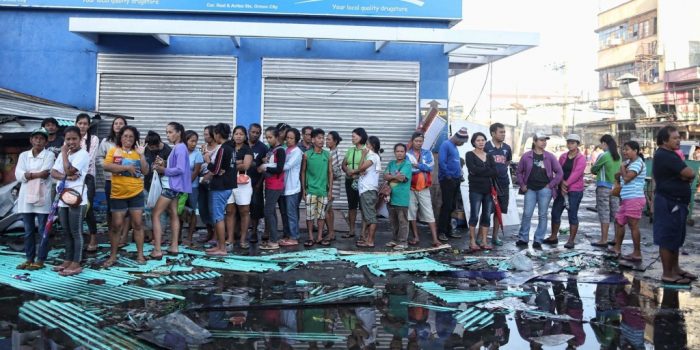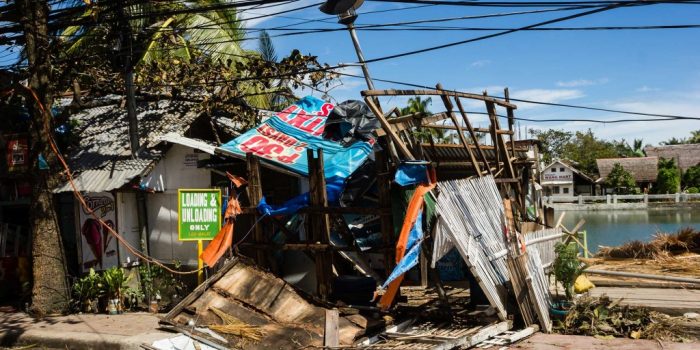The Puzzling Story of Media Coverage and Haiyan
Why hasn’t there been more American media coverage of theTyphoon Haiyan disaster? The death toll is now over 6,000 people, and hundreds of thousands are injured or homeless. This will go down as one of the most powerful and destructive storms in history. The Conrad A. Hilton Foundation reports that almost two-thirds of contributions to […]
Why hasn’t there been more American media coverage of theTyphoon Haiyan disaster? The death toll is now over 6,000 people, and hundreds of thousands are injured or homeless. This will go down as one of the most powerful and destructive storms in history.
The Conrad A. Hilton Foundation reports that almost two-thirds of contributions to a disaster are made within the first two months after a disaster hits. In the case of Haiyan, the fundraising period seems to have been even shorter.
Development Initiatives reports that 15 days after the Typhoon, fundraising for Haiyan was just a fraction of the amount raised for other major international disasters. Despite the fact that over five times as many people were affected by this disaster than by the 2004 Indian Ocean tsunami, less than a sixth had been given at the same point in the response. Their conclusion was that the disparity was caused by a variety of factors including “media profile and global economic climate. Or perhaps perceptions of the severity of need, of the cost of responding in each of the contexts, or of the existing coping capacity.”
A story in the Associated Press (AP) about the funeral of Nelson Mandela last week gave me another possible insight into a reason for the dearth of Philippine coverage. According to the AP, “NBC’s Brian Williams is anchoring his nightly newscast from South Africa early this week … but ABC and CBS are keeping top anchors Diane Sawyer and Scott Pelley in New York… The moves show how economics and a dwindling interest in international news are changing the biggest broadcast networks, where a decade ago there would have been little question that their most prominent faces would be on hand for such a big story.”
The article points out that lack of foreign coverage wasn’t always the case: “Earlier in her tenure, Sawyer traveled to Haiti for an earthquake there and to Japan in the wake of a tsunami. But none of the top anchors went to the Philippines this year following one of the world’s most powerful typhoons.”
Is Obamacare to blame?
The Pew Research Center suggested another reason might be that the “continuing travails of Obamacare” contributed to lack of Philippine coverage. Their survey conducted Nov. 14-17 found that 37% of Americans said they were following the health care rollout story very closely compared with 32% who were following news about the Philippines disaster very closely. And cable television was following the two stories closely as well. But after President Obama took steps to prevent cancelation of individual health policies, some of the cable networks all but stopped covering the Philippines.
A Pew analysis of certain mid-day and prime time hours found CNN had the closest balance between the two stories, spending slightly more than three-and-a-half hours on Obamacare and just under five hours on the typhoon. The fledgling Al Jazeera America network devoted three hours and 10 minutes to the typhoon, more than twice as much airtime as health insurance commanded (1.5 hours). But unfortunately, its audience is tiny compared to the more well-known cable channels.
A TIME Magazine commentary by John Crowley of the Harvard Humanitarian Initiative blamed the lack of human interest in part on negative media coverage. “When television crews race large cargo ships with airplanes and helicopters, the cameras will always win. Journalists will report on the gap between supply and demand. They will show the faces of people in need of Western largesse. They will turn isolated incidents of foraging and removal of goods from a truck or warehouse into a report on rampant looting. Here is where the reports go very wrong. According to a friend who has worked in Haiti and the Philippines, ‘What happens when media talk up security issues is that aid agencies get worried about security of distributions, so they hold off until they have adequate security support. The velocity of distribution is dramatically slowed down. Scaremongering undermines the relief effort.’ This dynamic happened in Haiti, and it’s happening here.”
The most visible American journalist in the Philippines was CNN’s Anderson Cooper who spent several days covering the disaster. He himself became the subject of news stories when he began to criticize the Philippine government for lack of planning and a poor recovery effort.
Global Voices – my favorite web site for reading Twitter feeds on international stories – has a fascinating summary of the debate on Twitter about Cooper’s opinions. Many Twitter reactions were like this one: “I’d rather believe those people on the field like @andersoncooper than those inside the news room.” But there were an equal number of negative comments as well: “Anderson Cooper’s coverage of the Haiyan disaster in Tacloban is a good example of parachute journalism and scaremongering.” Law professor Florin Hilbay probably summed up the situation best: “regardless of whose side you’re on, the journalist should not be the news.”
What can we learn, and do, about this?
One of my New Year’s resolutions is to never write about a problem in my blogs without also offering some solutions. So what are we to learn and what steps can we take to find some solutions? It seems apparent that media coverage was less than we might have expected. At the same time–and probably as a consequence–philanthropic contributions are also less than we might expect for a disaster of this magnitude. But the effects of this disaster aren’t over yet and there is still much we can do.
An important role for journalists can still be covering the long, arduous task of recovery and rebuilding. How do people rebuild their homes, communities and livelihoods? Wouldn’t it be great if the media could cover the efforts by the Filipino people to build a more resilient country? This could be a lesson that benefits the entire world. As Crowley from the Harvard Humanitarian Initiative points out: “When journalists focus on looting and slow aid delivery, they miss the point. Information is aid. Their reports are part of weaving the fabric of a global Filipino community back together after a typhoon tore through their hometowns. By showing communities coming together, journalists can amplify the dynamics that save lives.”
And as for us philanthropists, there is still much we can do as well. The recovery and rebuilding will take years and cost billions of dollars. It’s not too late for you to participate. While many immediate needs have been met, the mid to long-term recovery needs are still emerging.
As you think about your year-end giving, consider the work of CDP’s Typhoon Haiyan Recovery Fund, and see our coverage of NGOs working in the Philippines, many of whom are focused on the long view.
More like this

Haiyan Recovery Still Has Long Road Ahead

